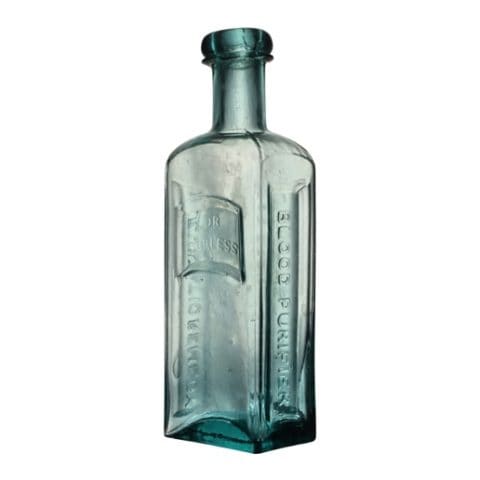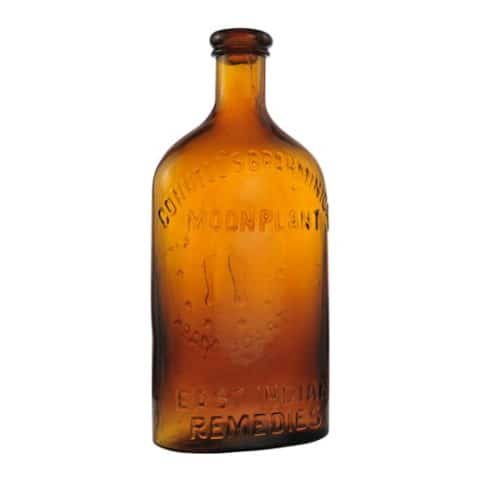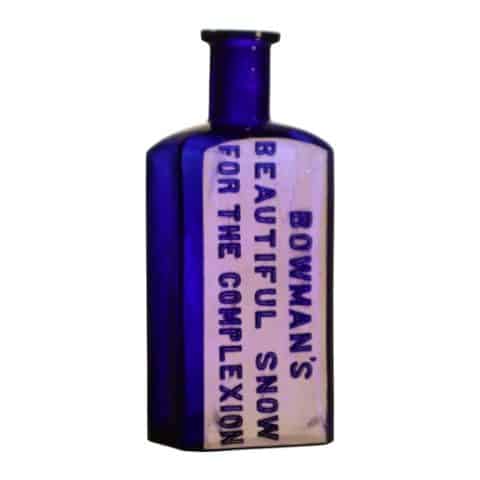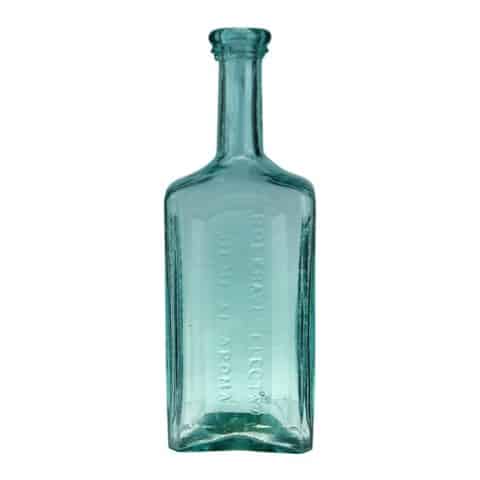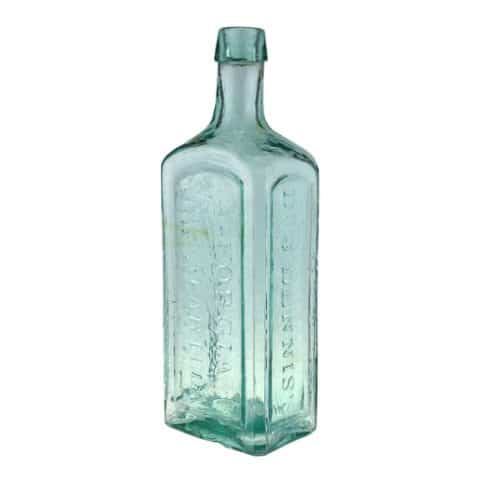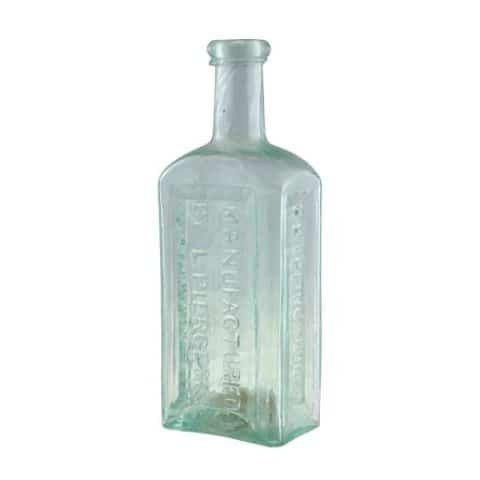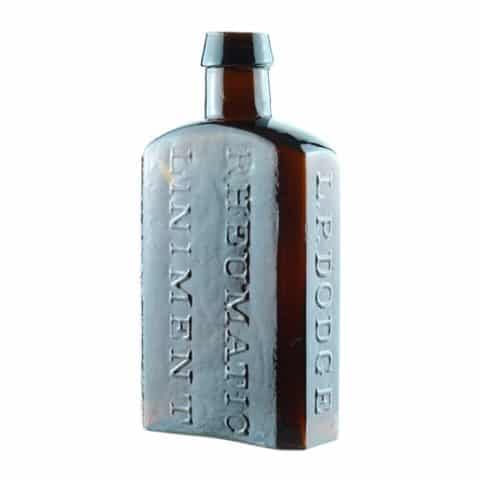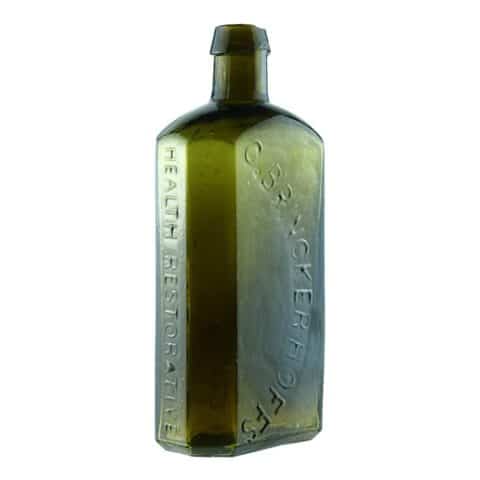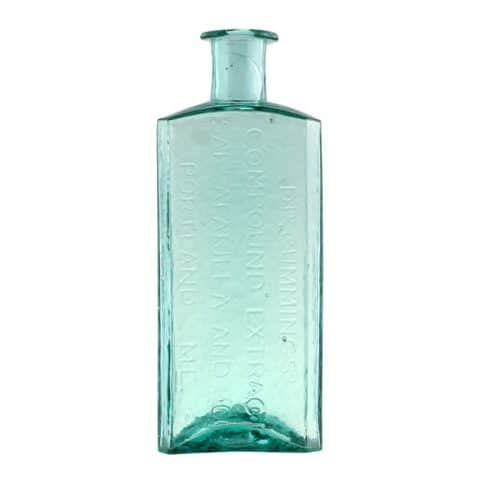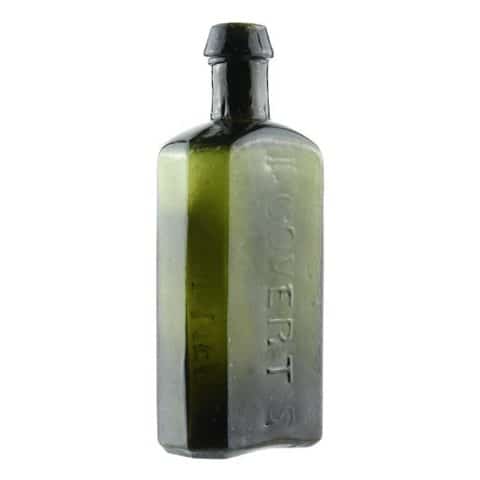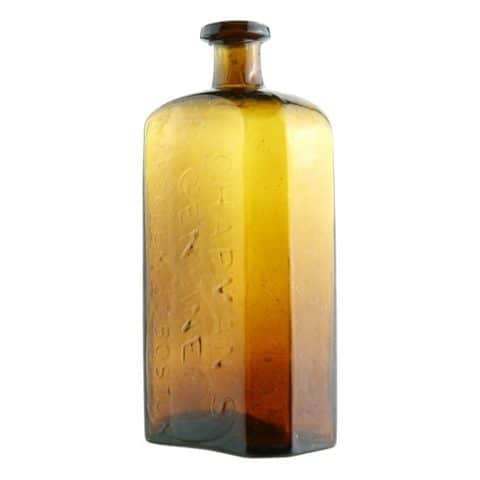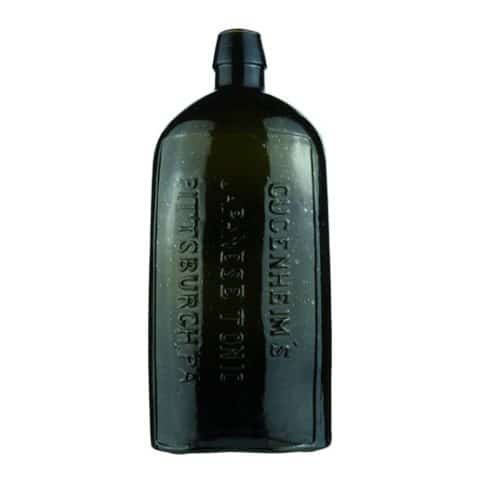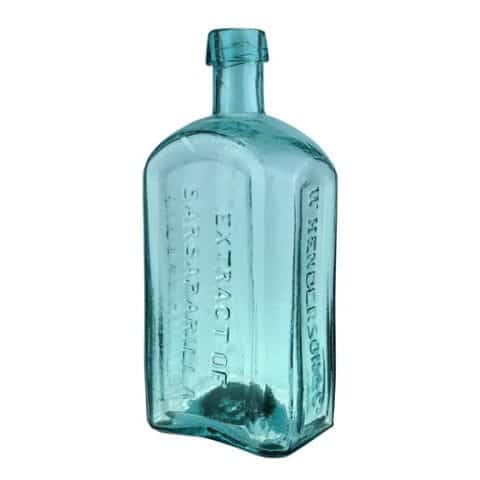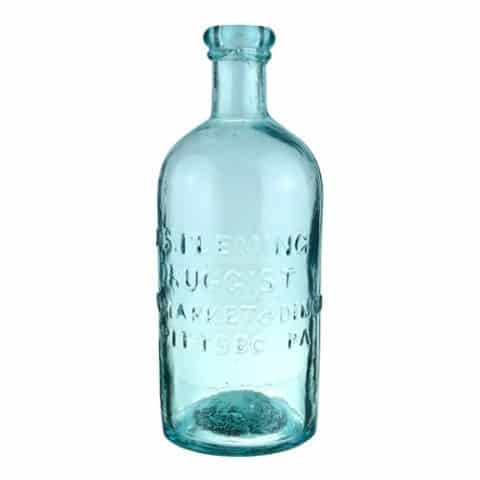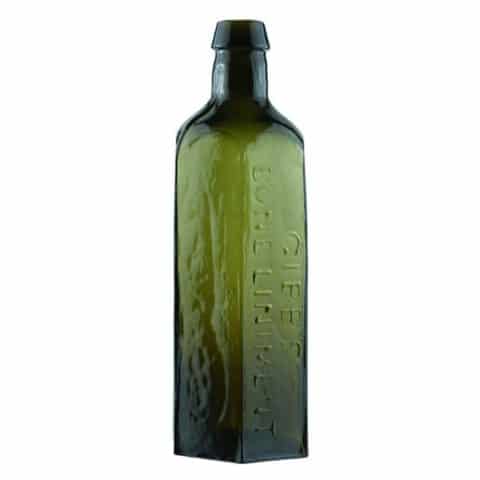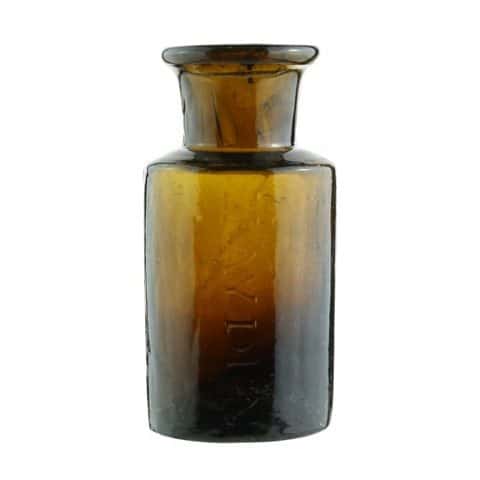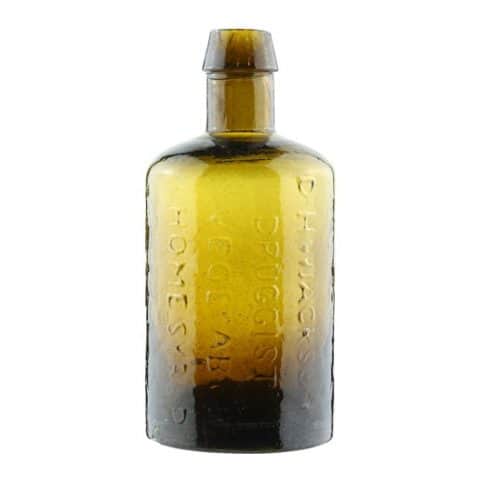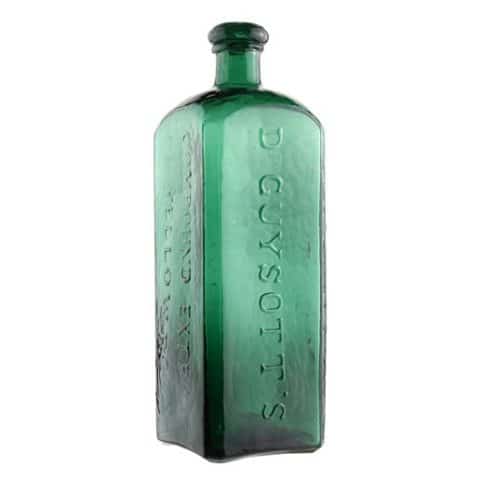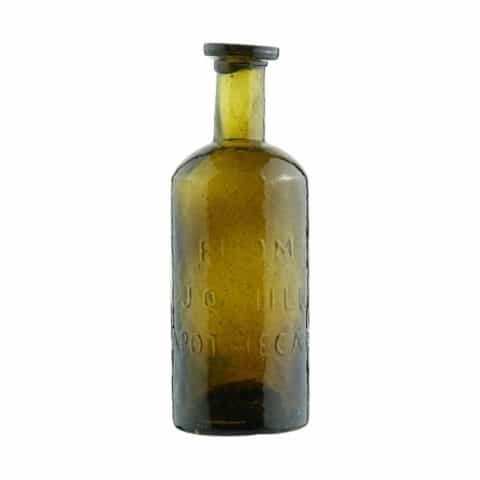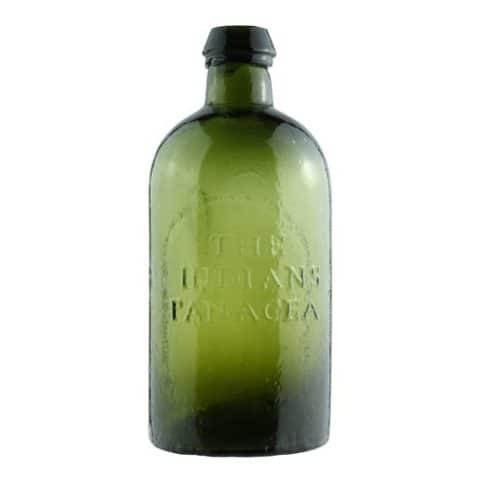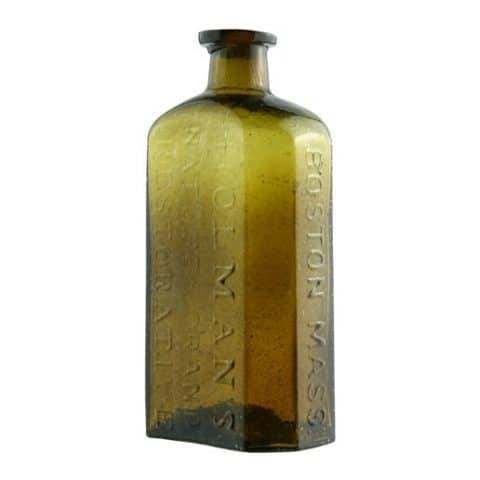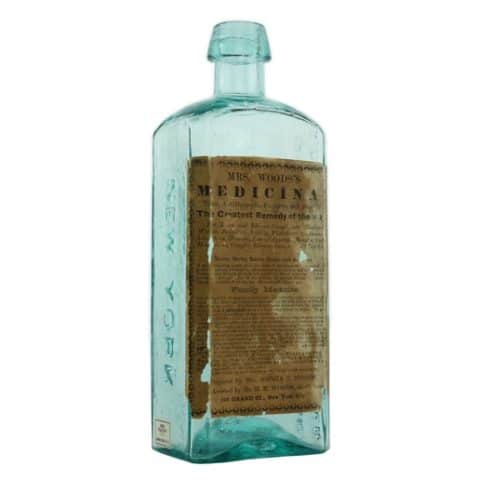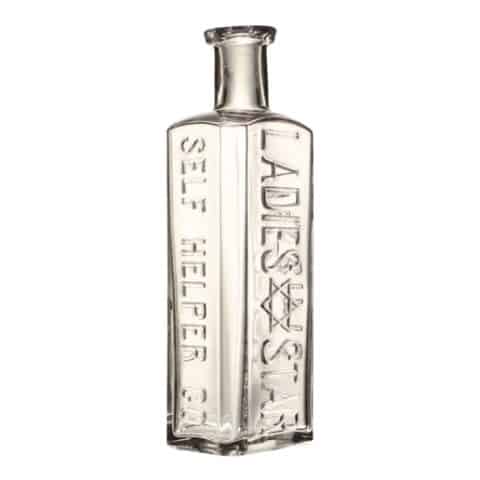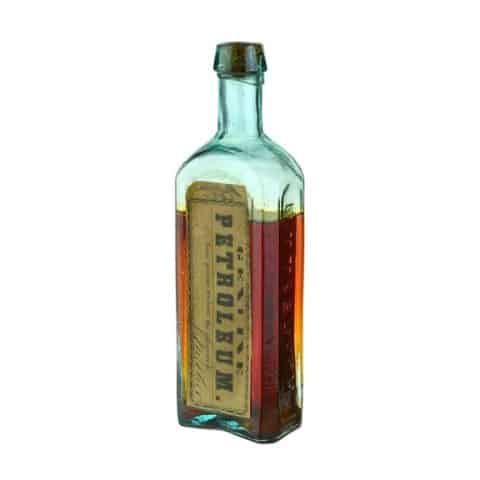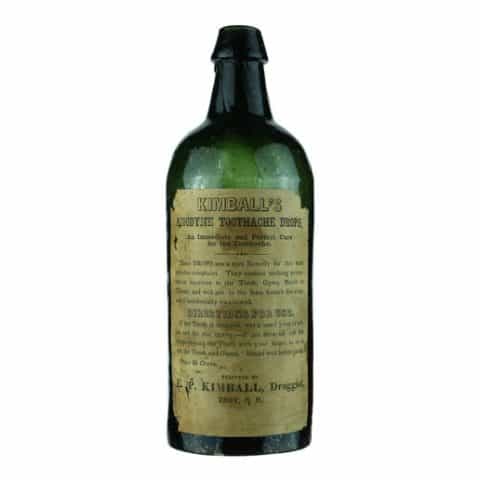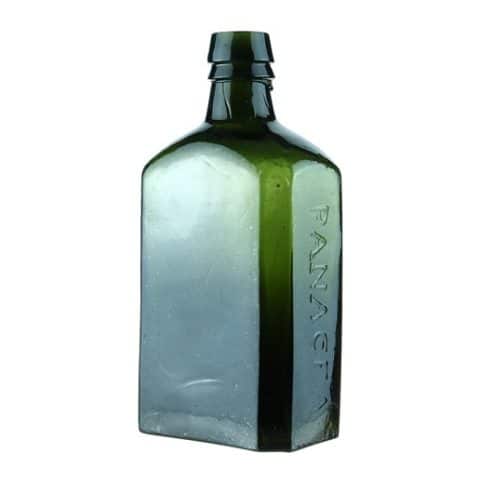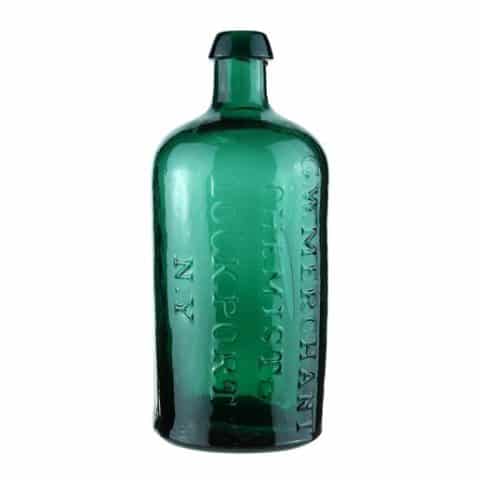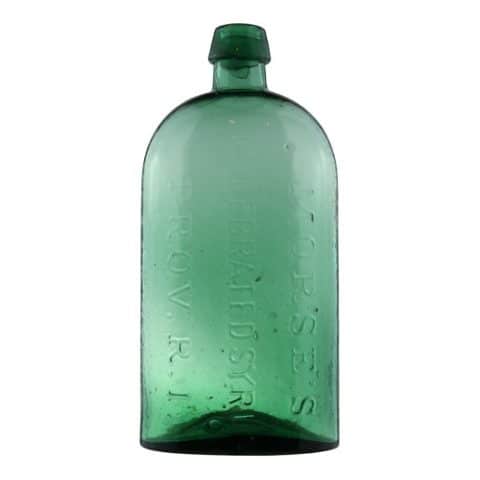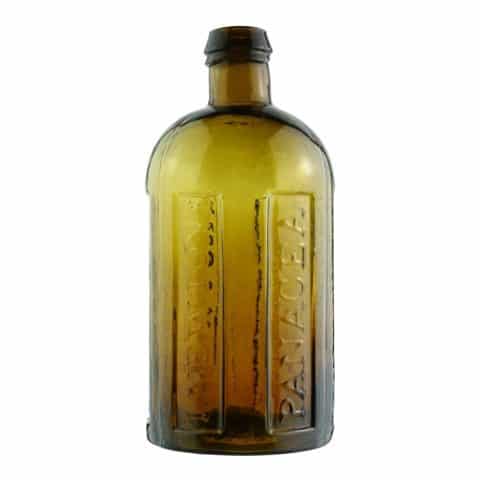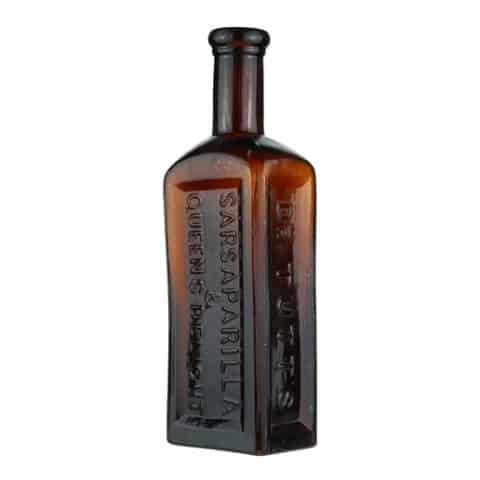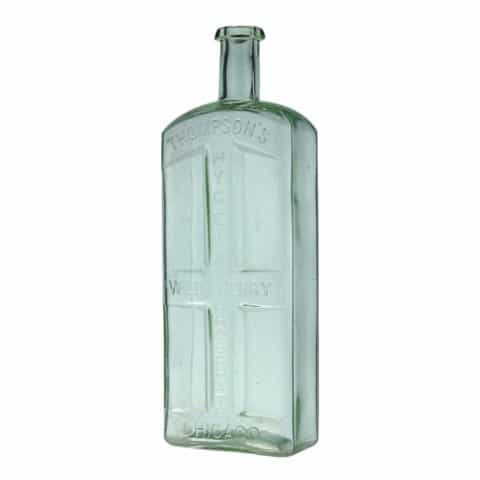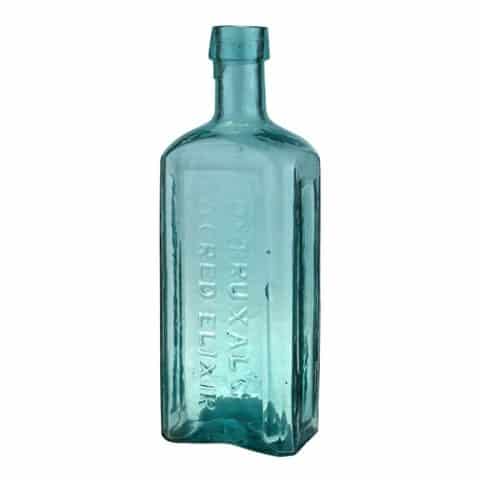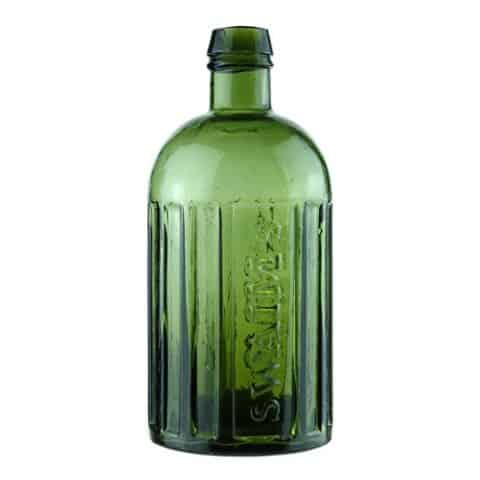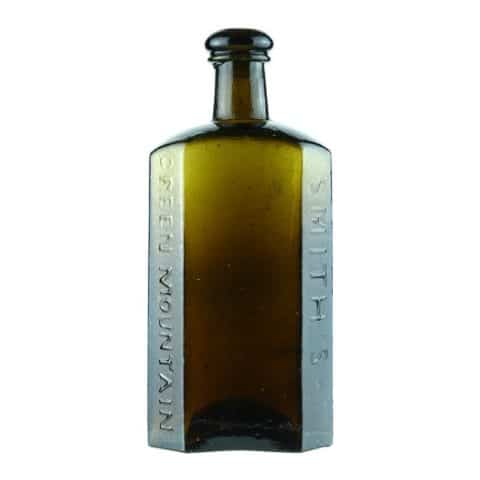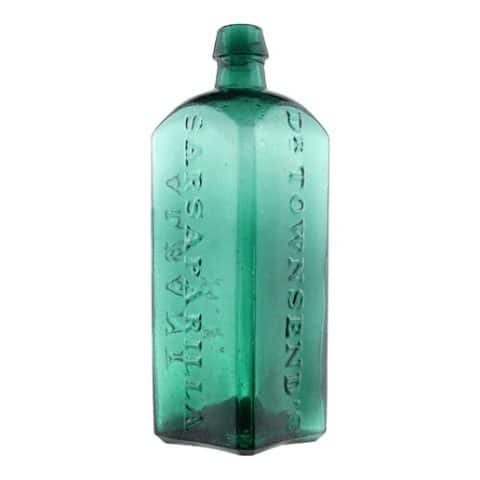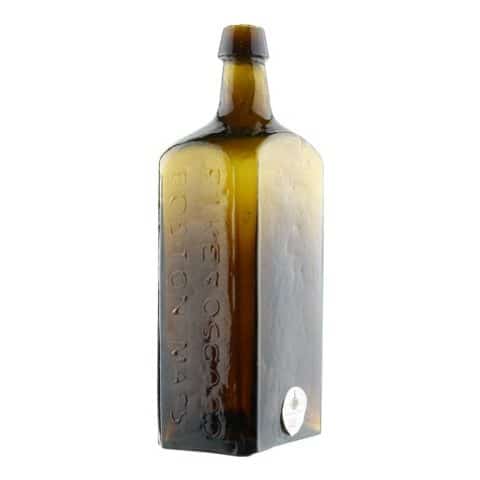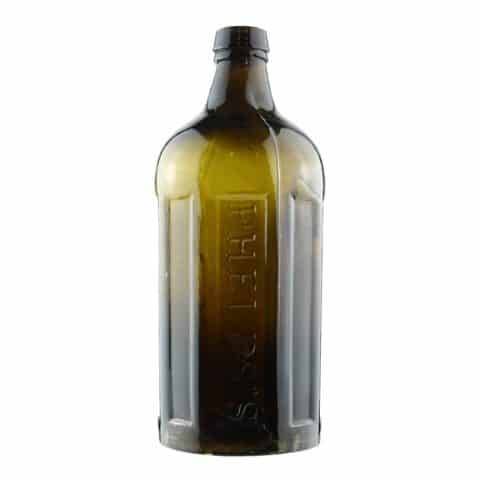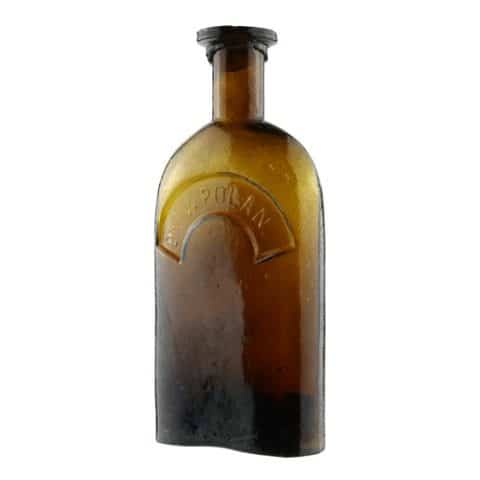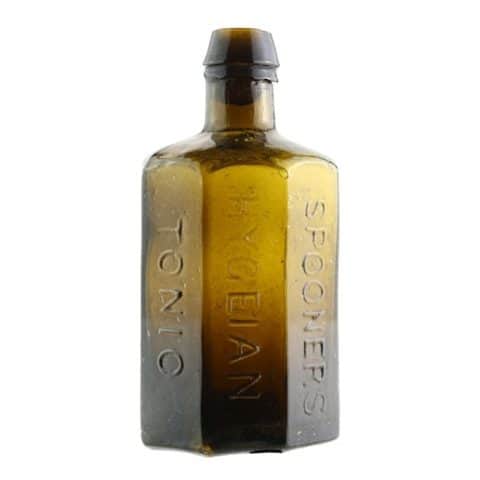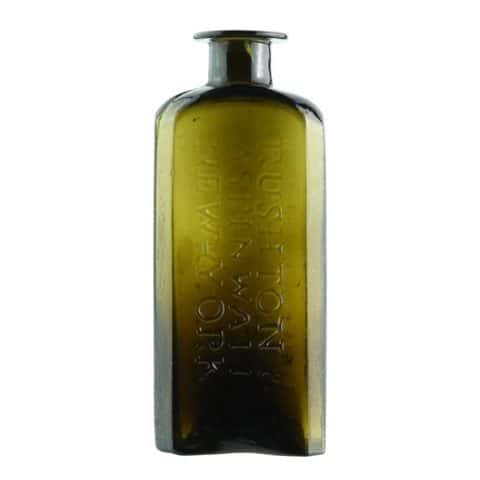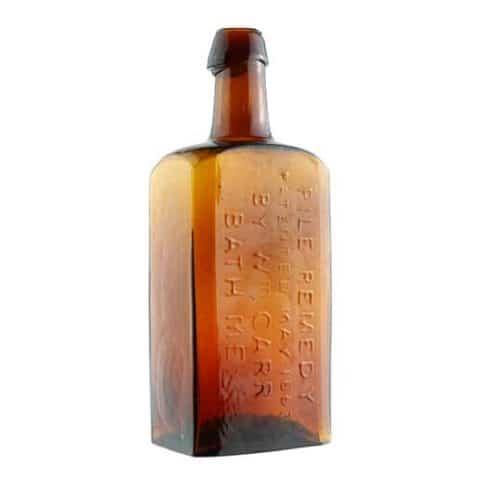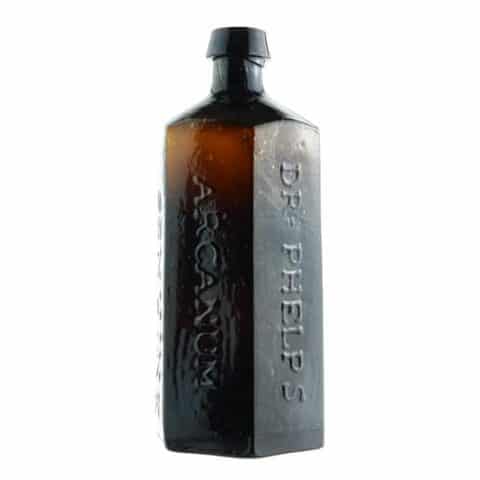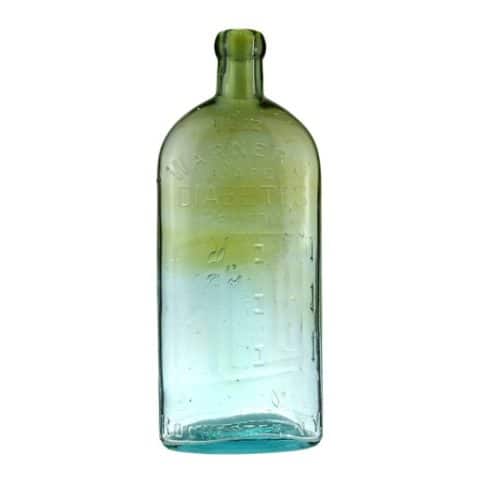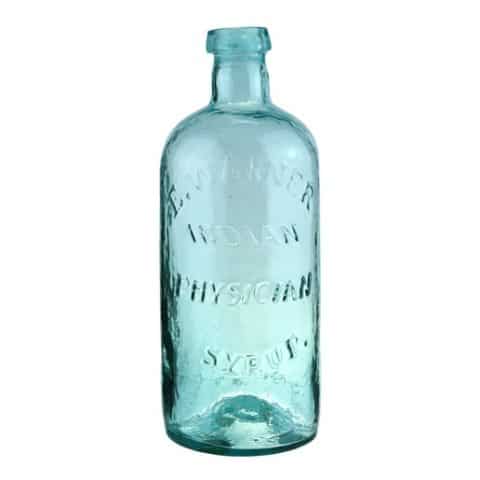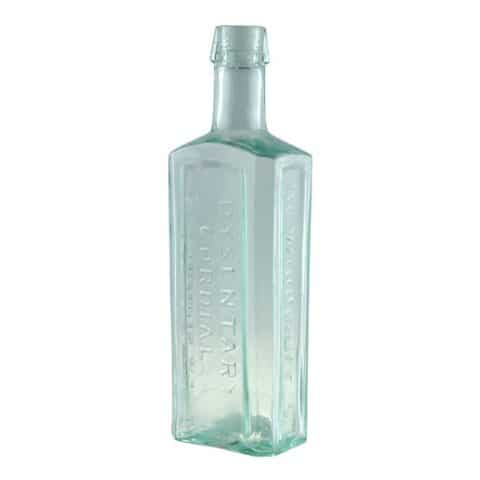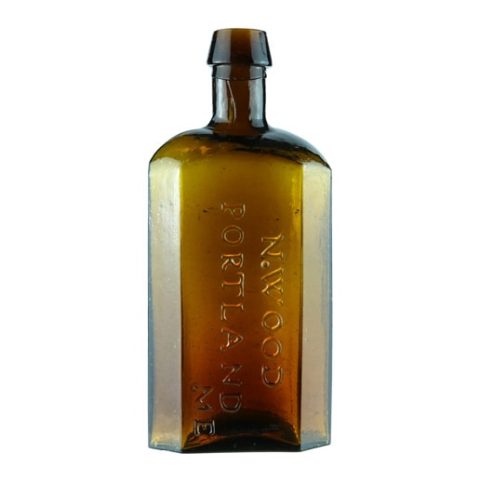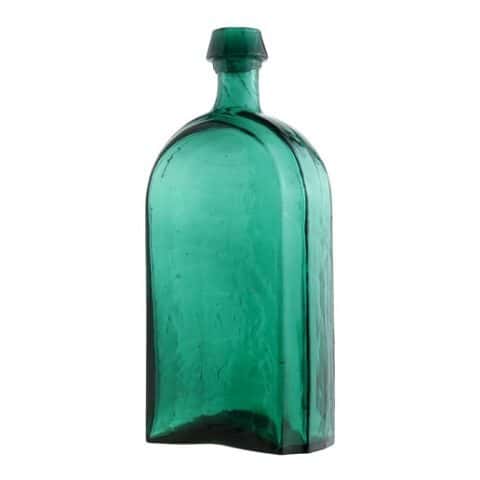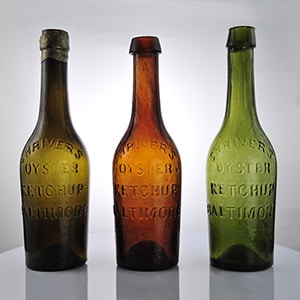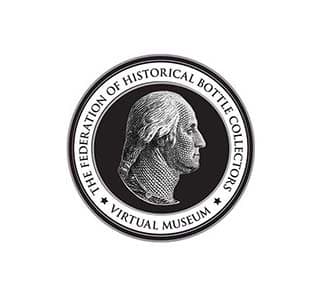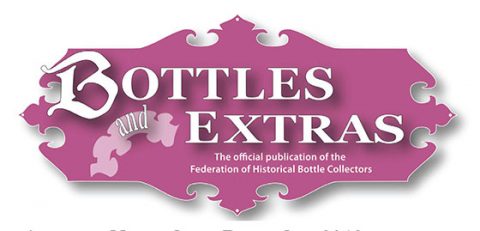Dr. J.S. Woods Elixir Albany, NY
Dr. J. S. Wood’s Elixir
Albany. NY
Dr. John S. Wood, Albany, New York
Deep Blue Green Tombstone Medicine Bottle
Provenance: Michael George Collection
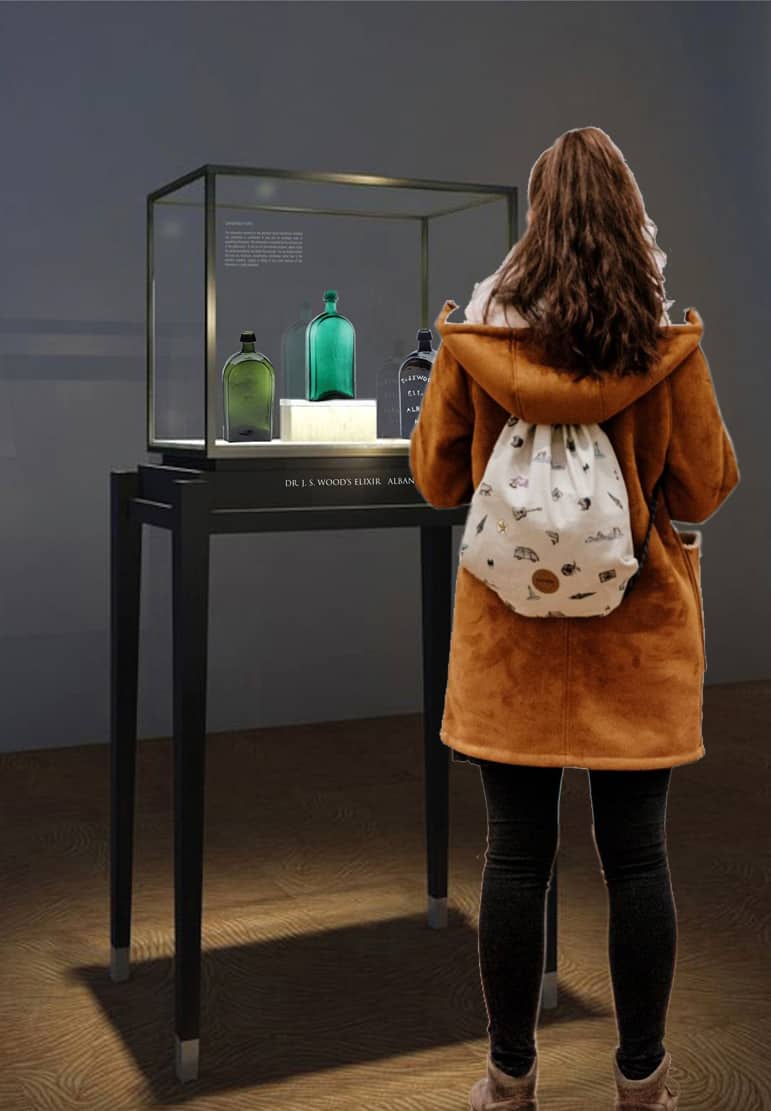
John S. Wood was born sometime in 1811 in New York where his parents were both from. There are no records of his early life referencing his schooling or childhood though he married Maria L. Eaton in the 1830s. They would go on and have many children. Dr. Wood was primarily a successful dentist and surgeon and for a short period in the mid to late 1840s, he produced and sold a medicine and had his name and city, “Dr. J. S. Wood’s Elixir, Albany, NY” embossed on a bottle.
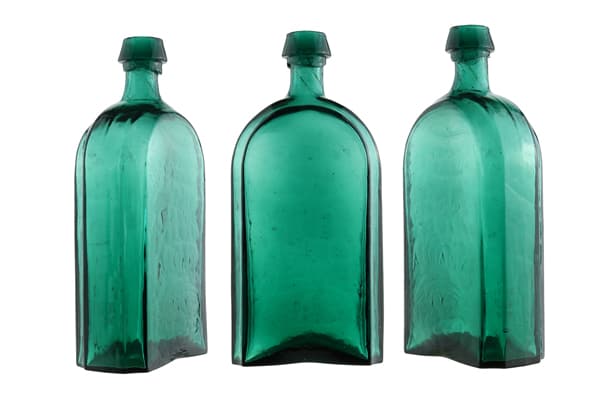
Our museum example of a 9″ tall “Dr. J. S. Wood’s Elixir Albany. NY” medicine bottle is in a rectangular tombstone form with concave corners. The contents were a little more than a quart. The glass color can best be described as rich deep blue-green. There is an applied double sloping collared mouth and an iron pontil. The lettering is weak as is usual for this bottle though our bottle has a slightly more pronounced embossing. This lettering occurs horizontally in four lines on the broad face of the bottle. The first three lines are arched, ‘DR. J. S. WOOD’S’ (1st line arched), ‘ELIXIR’ (2nd line arched), ‘ALBANY.’ (3rd line arched, a period after Albany) and ‘NY’ (4th line straight). The opposite panel would have been where a paper label would have been placed. This rare and desirable bottle has excellent character, is crude, and is usually seen in shades of blue-green glass. The bottle has also has been reported in emerald green and deep yellow-olive glass colors which are both represented in the museum.
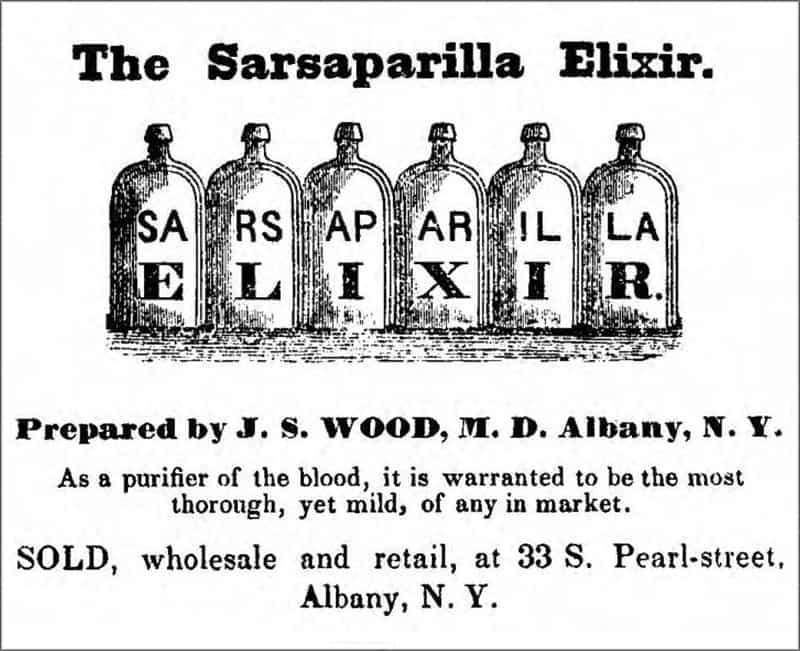
In 1845, we see the first advertisement for “Dr. Wood’s Elixir” being sold as cough medicine and “One of the most efficacious remedies ever discovered.” By 1848, Dr. John Wood lengthened the name of his product to compete with competitors and was calling his medicine “Dr. J. S. Wood’s Elixir of Sarsaparilla, Yellow Dock and Wild Cherry” or simply “The Sarsaparilla Elixir.” His medicine was put up in tombstone-form bottles that were probably made at one of the New York State glass factories and most probably Albany Glass Works.
The previously noted 1848 advertising occurred in many New England and Northeast newspapers and was headlined “Dr. J. S. Woods Sarsaparilla Elixir! Warranted superior to any other preparation, compounded or extract of Sarsaparilla ever offered to the American people.” Advertising went on to say that the bottles contained six times the quantity of Sands’ or Bristol’s Sarsaparilla and four times as much as Bull’s Sarsaparilla and that they thought it was stronger than either, and at least four times as strong as Townsend’s Sarsaparilla. They also said it was four times the cheapest Sarsaparilla in the market. Dr. Wood was selling his elixir wholesale and retail at Dr. J. S. Wood’s Sarsaparilla Depot, No. 33 South Pearl Street in Albany, New York. The company name was Wood, Lyon & Co. This was a very short partnership with Dr. Abel Lyon. Advertising for Dr. Wood’s Sarsaparilla Elixir would continue through 1850 and stop.
Note: There is a Dr. Wood’s Sarsaparilla & Wild Cherry Bitters that was advertised and sold throughout New York State from around 1844 to 1851 or so. Some of the advertisements said that it was put up and sold in large $1 bottles by Wyatt & Ketcham, who were wholesale and retail agents located at 192 Broadway and 311 Bleecker Street, in New York City. This is probably not the same Dr. Wood and may have been why Dr. J. S. Wood always used his initials in front of “Wood.”
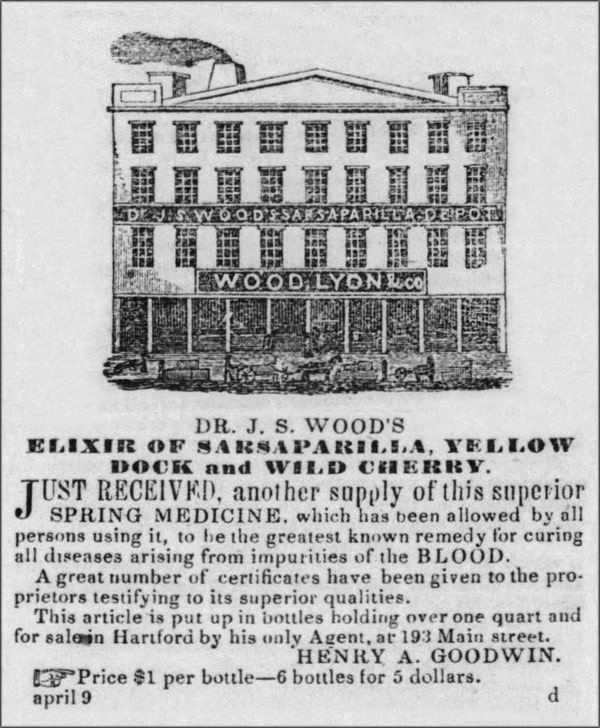
Dr. Wood was always listed as a dentist by profession and sometimes had surgeon or physician by his name in New York State and United States Federal Census records. By 1852, his Albany newspaper advertisements said “J. S. Wood, M. D., Dentist and Surgeon. Operations on the teeth carefully performed, with the least pain possible, and in the most perfect manner.” The ads noted that he had been practicing for many years and could insert a single tooth and up to a complete set. Decaying teeth were prevented from decay by plugging with fine gold. He was also providing services as cleansing and extracting. This was all happening at his office and residence at 81 Hudson Street at the corner of Pearl which could have been the same address of his Sarsaparilla Depot from four years earlier. Dr. Wood was also retailing at this address selling “Tooth Paste, for beautifying and preserving the teeth, Toothache Drops, Washes, &c.” In another area of his office presumably, he was providing surgical operations “upon the eye, ear, lips, and for club-foot, &c. &c., executed in accordance with the most approved principle of surgical science.”
Sometime between 1855 and 1860, Dr. Wood and his large family would move to Lansing, Michigan where he continued his dentistry practice. Oddly, we do not see his death recorded which was after 1880 where he was last listed in a federal census.
Primary Image: Dr. J. S. Woods Elixir, Albany N.Y. bottle imaged on location by Alan DeMaison, FOHBC Virtual Museum Midwest Studio
Support Image: Auction Lot 82: “Dr. J.S. Woods / Elixir / Albany. / NY” Medicine Bottle, probably Albany Glass Works, Albany, New York, 1848-1850. Tombstone form, emerald green, applied sloping collared mouth – iron pontil, ht. 8 1/2 inches; (lettering is weak as is usual for this bottle, very light scratch across the top half of the front of the bottle ). N #700 Extremely rare, beautiful color, fine condition. Found in a pawn shop in Florida – Norman Heckler Jr. & Sr., Norman C. Heckler & Company, Auction #99
Support Image: Auction Lot 8: “Dr J S Wood’s / Elixir / Albany / NY” Medicine Bottle, America, probably Albany Glass Works, Albany, New York, 1847-1850. Rectangular with concave corners, deep yellowish olive, applied sloping collared mouth – iron pontil mark, ht. 8 3/4 inches; (2 1/2 inch fissure in mouth and neck with 1/4 inch mouth bruise, manufacturing pontil chip comes to edge of base, 1/8 inch open bubble on reverse). Similar to AAM pg. 579 Usually seen in shades of green, this yellowish olive example is extremely rare and unlisted in this color. – Norman Heckler Jr. & Sr., Norman C. Heckler & Company, Auction #146
Support Image: Auction Lot 62: “DR. J.S. WOOD’S / ELIXIR / ALBANY / N.Y.”, (Odell, pg. 379), New York, ca. 1840 – 1860, blue-green tombstone form, 8 3/4”h, iron pontil, applied tapered collar mouth. About perfect. (having a minor lip flake) Brilliant color with more blue than normally seen, plenty of glass whittle, and a better than normal impression, which oftentimes can be barely legible on this bottle. – Jim Hagenbuch, Glass Works Auctions, September 2014
Support Image:
“DR. J.S. WOOD’S / ELIXIR / ALBANY / N.Y.”, probably 1847 – 1849. Rich, deep bluish-green with an emerald tone, rectangular tombstone form with concave corners, applied sloping collar – iron pontil scar, ht. 8 ¾”, near mint; (a little light high point wear, and a 1/8″ panel edge flake). Odell, p.379. A big, beautiful, eye-appealing example, rich color, whittled wavy glass, excellent condition. The embossing is often very weak on this mold. This is a much better-than-average example! Per the book, Old Albany Bottles, John S. Wood was first listed in 1847 with Philo. D. Lyon, a grocer, as manufacturers of sarsaparilla “put up in quart bottles with Dr. J.S. Woods Elixir on the front panel”. In 1849, the company was no longer listed in the directories. An 1848 advertisement depicts a drawing of the bottles with “The Sarsaparilla Elixir” at the top of the ad. – John Pastor, American Glass Gallery, Auction #31
Join the FOHBC: The Virtual Museum is a project of the Federation of Historical Bottle Collectors (FOHBC). To become a member.






